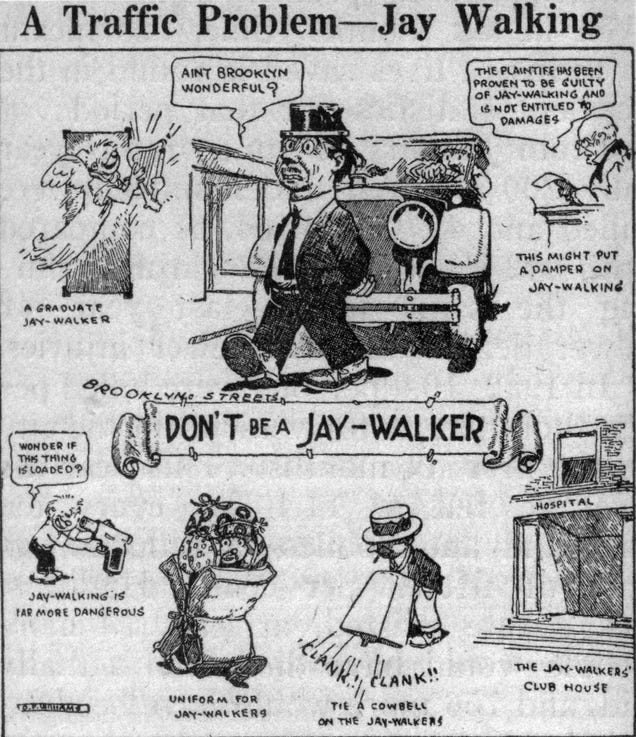
4 minute read
"Inventing Jaywalking" Vol. 20: #26 • (6-23-2024) Tidbits of Coachella Valley
Jaywalking was not always a thing. Jaywalking had to be invented. And it may not come as a surprise that it was invented by the automobile industry.
• Before cars were common, city streets were clogged with horses and carriages, kids playing ball, vendors, ladies chatting, etc. Pedestrians crossed the street wherever they wanted. There were no stoplights, crosswalks, or rules of the road.
• In the 1920s, automobiles became increasingly common. Drivers were tasked with the responsibility of avoiding obstacles in the road, including dogs, carts, streetcars, and kids. Predictably, the number of pedestrians injured or killed by cars increased sharply, with the elderly and children most affected. Blame always fell on the driver, regardless of circumstances. Public outcry against these dangerous vehicles was intense.
• Whenever a traffic accident of any kind ended up in the courts, the judge invariably blamed whatever vehicle was largest. In cases where vehicles killed pedestrians, the driver would generally be charged with manslaughter. Newspapers were full of articles and cartoons demonizing cars.

• Anti-automobile coalitions gathered and joined forces, insisting that rules be passed. The crux was reached in 1923 when 42,000 citizens of Cincinnati, Ohio, signed a petition to put a ballot initiative to the vote requiring that all cars have a governor installed that would limit them to 25 mph.

• This terrified local car dealers, who collectively sprang into action. Letters were sent to every single car owner in the city asking them to vote against the proposal. Advertisements were run in local newspapers. Because of this effort, the measure failed.
• This sparked automobile groups from coast to coast to ban together and join the effort. It was clear that if they didn’t get on top of this situation quickly, it posed a severe threat to the entire auto industry.
• Auto enthusiasts joined forces to create a national publicity campaign to turn the tables, restricting the movement of pedestrians instead of the cars, and requiring accident reports to also include faults on the part of pedestrians.

• Meetings with top government officials resulted in a set of traffic laws that would apply to all cities across the country. In 1928, Los Angeles was the first to implement the Model Municipal Traffic Ordinance which specified, among other things, that pedestrians were allowed to cross the street only at crosswalks and only at right angles but not diagonally. This is still the official law today.
• The next problem lay in convincing not only the populace but also the police to follow these laws. They were rarely enforced, and judges often tossed the cases out of court. So the automobile industry geared up again to apply more pressure at key spots.
• One tactic was to create the National Automobile Chamber of Commerce. This group set up a free wire service for newspapers. Any reporter could send in a form outlining the circumstances of a local incident, and they would receive in return a complete article ready to print. All of these articles shifted blame due to the pedestrian rather than the vehicle: “A young boy was injured after dashing into traffic” instead of “Another vehicle struck and injured a young boy.” These articles underscored the fact that it was often the pedestrian’s fault, not the driver’s.

• School safety campaigns and poster contests taught the lesson at a young age. Even the name of the infraction: “jaywalking” was chosen for maximum impact. Back then, the word “jay” referred to a country bumpkin– someone unschooled in the wise ways of a city slicker.
• The campaign worked. Cars successfully took ownership of the streets of the nation, now forcing pedestrians to observe and obey the marked sidewalks and crosswalks.


